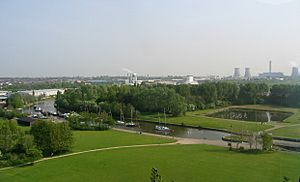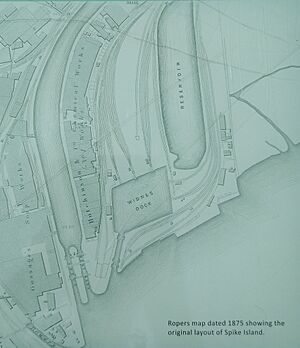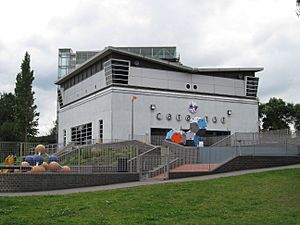Spike Island, Widnes facts for kids
Quick facts for kids Spike Island |
|
|---|---|

Spike Island viewed from Catalyst Science Discovery Centre
|
|
| Type | Park and Urban open space |
| Location | Widnes, Cheshire, England |
| Operated by | Halton Borough Council |
Spike Island is a fun park in Widnes, Halton, England. It's a special island between the old Sankey Canal and the River Mersey. You can find parkland, woods, and walking paths there. It's also right next to the Catalyst Science Discovery Centre, which is a cool science museum.
Spike Island was once a very important place for the chemical industry in Britain, especially during the time of the Industrial Revolution. In 1833, the world's first dock where trains could load goods directly onto ships was built here. Later, in 1848, the first chemical factory in Widnes was built on the island by John Hutchinson. The chemical industry grew super fast after that! But by the 1970s, all the factories were gone. From 1975, the island was cleaned up and turned into the lovely park you see today.
A very famous concert by the band The Stone Roses happened on the island in May 1990. There's even a movie about it called Spike Island.
Contents
Spike Island's Past: From Industry to Park
Spike Island is not a natural island. It was made in 1833 when the Sankey Canal was made longer. The canal was extended from Fiddler's Ferry all the way to the River Mersey in Widnes. This extension cut off a part of Widnes, making it an island. The canal used to go from Spike Island to Warrington and then to St. Helens. The canal wasn't used much after a while and closed in 1963. Now, the path along the canal is part of the Trans Pennine Trail, which is great for walking and cycling.
The World's First Rail-to-Ship Dock
Widnes Dock was built in 1833. It was the first dock in the world where trains could unload goods directly onto ships. Imagine coal being taken off a train and put straight into a boat! These boats then traveled along the River Mersey to other parts of the UK and even abroad. Goods could also come by boat and be loaded onto trains for local factories. The dock was kept full of water from a nearby reservoir. This stopped the water level from getting too low when the River Mersey's tide was out. Widnes Dock was last used for business in 1931. However, the island was still used for railway sidings, which are special railway lines for storing and organizing trains. These lines were known as "Marsh Sidings." They were used until 1968.
Mersey Flat Boats
Big ships can't sail far up the River Mersey because the water isn't deep enough. So, smaller boats called Mersey flats were used at Widnes Dock. These boats could carry goods down to the Port of Liverpool or along the canal. The dock could hold up to 40 boats at once. A Mersey flat could be loaded with 70 tons of coal from a train in just 40 minutes! Mersey flats were small, flat-bottomed sailing barges. They were very common in the 1800s. You can still see the remains of a Mersey flat boat called the Eustace Carey at Spike Island when the tide is low.
Spike Island's Chemical Industry History
In 1848, John Hutchinson built the first chemical factory in Widnes on Spike Island. It was called "Hutchinson's No 1 Works" and was next to the Sankey Canal. After this, many more chemical factories appeared in the town. Around 1860, Hutchinson built Tower Building. This building was the main office for his chemical business. Later, it became the head office for the Gossage soap company. This company was once the biggest soap company in the UK! Today, Tower Building is home to the Catalyst Science Discovery Centre. John Hutchinson was known as "the father of Widnes." This was because he helped the chemical industry and the town grow so much.
Spike Island was at the heart of the British chemical industry in the 1800s. This was a big part of the Industrial Revolution. The chemical industry made it possible to produce things like soap, bleaching powder, glass, and fertilizer in large amounts. The number of people living in Widnes grew very quickly. However, the industry also caused a lot of pollution. The town became one of the dirtiest and most dangerous places to work in England. Over time, new rules about the environment helped to clean things up. By the 1970s, Spike Island had old, unused chemical factories, railway lines, and a polluted canal. Between 1975 and 1982, the island was cleaned up and turned into green spaces. All the chemical factories were removed. Only two old pyrite kilns remain from that time.
Things to Do at Spike Island Today
Halton Borough Council looks after Spike Island. They describe it as "Open parkland with items of industrial archaeological interest and a canal." There are lots of things to do and see! You can enjoy:
- Walking paths and canal walks
- Cycle paths
- Woodland areas and wetlands
- Great views of the River Mersey and the Mersey Gateway Bridge
- Lots of different birds
- Fishing spots
- Places to learn about the island's industrial past
- Picnic tables
- Car parking
- A sports pitch for different games
- A children's play area
- The Trans Pennine Trail also goes through the park.
Some Mersey riverboats are kept in the Sankey Canal. The canal has water, but you can't sail a boat past the island right now. Halton Borough Council hopes to make the canal usable for boats again in the future. They plan to build a new swing bridge on the island and reopen the way between the canal and the Mersey. They are also working to find a new water source for the canal.
Catalyst Science Discovery Centre
The Catalyst Science Discovery Centre is a museum all about science, especially chemistry. It's right next to Spike Island. The museum tells the story of Widnes and Spike Island. It has many hands-on displays where you can try things out. There are also static displays and live science shows. You can explore 80 interactive exhibits that bring science, maths, engineering, and technology to life! The museum has two teaching rooms for workshops and a café. On the top floor, there's an observatory that you can reach by a glass-walled lift. From the observatory, you get amazing views of the river, Widnes, and the Mersey Gateway Bridge, which opened in 2017.






